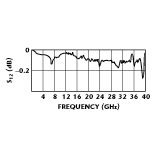SiGe Front-end RFICs
CommQuest, an IBM company
Encinitas, CA
The advantages of the silicon germanium (SiGe) semiconductor process have provided a price-to-performance ratio not available thus far from existing component technologies. SiGe power amplifiers achieve better than 55 percent power-added efficiency while today’s GaAs-based products offer no more than 45 percent in commercial applications such as GSM.
Two new SiGe products have been developed that feature a unique and unprecedented combination of power efficiency, performance, integration and  cost savings. The models CQT2240 tri-band low noise amplifier (LNA) and CQT2250 tri-band power amplifier/VCO (PA/VCO) complement the existing tri-band Total System Solution™ product offering, as shown in Figure 1 . Integrated into single devices, these SiGe ICs eliminate the need for multiple components in 900, 1800 and 1900 MHz front-end applications. The increased efficiency offered by these two ICs increases cellular handset talk and standby times significantly, and the increased integration of front-end components reduces manufacturing costs and allows for smaller handset designs.
cost savings. The models CQT2240 tri-band low noise amplifier (LNA) and CQT2250 tri-band power amplifier/VCO (PA/VCO) complement the existing tri-band Total System Solution™ product offering, as shown in Figure 1 . Integrated into single devices, these SiGe ICs eliminate the need for multiple components in 900, 1800 and 1900 MHz front-end applications. The increased efficiency offered by these two ICs increases cellular handset talk and standby times significantly, and the increased integration of front-end components reduces manufacturing costs and allows for smaller handset designs.
The CQT2240 tri-band LNA comprises separate amplifiers for GSM and digital  communications system (DCS)/PCS operation housed in a single 16-pin TSSOP package. Figure 2 shows the device’s configuration. Power gain for all three frequency bands is 15 dB, and each amplifier’s noise figure is 1.5 dB. The input third-order intercept point is –8 dBm for GSM and –10 dBm for DCS/PCS. The input power required to achieve 1 dB compression at the output is –18 and –20 dBm for GSM and DCS/PCS, respectively. Input/output SWR is less than 2, and the tri-band LNA operates from a 3 V DC ±10 percent power supply.
communications system (DCS)/PCS operation housed in a single 16-pin TSSOP package. Figure 2 shows the device’s configuration. Power gain for all three frequency bands is 15 dB, and each amplifier’s noise figure is 1.5 dB. The input third-order intercept point is –8 dBm for GSM and –10 dBm for DCS/PCS. The input power required to achieve 1 dB compression at the output is –18 and –20 dBm for GSM and DCS/PCS, respectively. Input/output SWR is less than 2, and the tri-band LNA operates from a 3 V DC ±10 percent power supply.
The CQT2250 tri-band PA/VCO comprises dual built-in PAs with dual detectors and a VCO and divider network to reach the tri-band outputs. Figure  3 shows the IC’s block diagram. The PA/VCO features an output power of greater than 34 dBm at 900 MHz and greater than 31 dBm at 1800 to 1900 MHz. The amplifier is capable of operating into a load SWR of 10 through all phases without permanent damage. The device’s phase noise at 10 kHz offset is –96 dBc/Hz for 900 MHz GSM operation and –88 dBc/Hz for 1800 MHz DCS and 1900 MHz PCS operation. Phase noise at 20 MHz offset is –162 and –154 dBc/Hz for GSM and DCS/PCS, respectively. The PA/VCO IC operates from a 3.6 V DC supply and is supplied in a 28-pin TSSOP package.
3 shows the IC’s block diagram. The PA/VCO features an output power of greater than 34 dBm at 900 MHz and greater than 31 dBm at 1800 to 1900 MHz. The amplifier is capable of operating into a load SWR of 10 through all phases without permanent damage. The device’s phase noise at 10 kHz offset is –96 dBc/Hz for 900 MHz GSM operation and –88 dBc/Hz for 1800 MHz DCS and 1900 MHz PCS operation. Phase noise at 20 MHz offset is –162 and –154 dBc/Hz for GSM and DCS/PCS, respectively. The PA/VCO IC operates from a 3.6 V DC supply and is supplied in a 28-pin TSSOP package.
Both the tri-band LNA and PA/VCO chips are designed for use in GSM mobile handsets and are sold exclusively for use as part of the Total System Solution product, which includes hardware, software, reference design and engineering/test support. The chipset is used in the short run by tier two and three manufacturers seeking rapid, cost-effective market entries. These manufacturers are able to improve power efficiency from approximately 40 to 45 percent to over 60 percent by using the CQT2240 and CQT2250 devices. In addition, they save 30 percent on the bill-of-material cost as a result of the elimination of dedicated individual LNAs and PAs for each operating band. LNA samples are scheduled to be available in early 1999; PA/VCO samples are available immediately.
CommQuest, an IBM company,
Encinitas, CA
(760) 633-1618.
